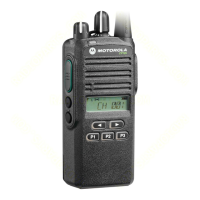5-14 Radio Programming and Tuning: Receiver Tuning
5.7.2 Receive 12.5 kHz-Band Normal Squelch Tuning
1. Under the Alignment menu, select Rx Squelch, then select Squelch 12.5 kHz-band Normal.
(Figure 5-9. Rx 12.5 kHz-band Normal Squelch Tuning Window).
2. Apply a RF signal (with 1 kHz tone at 1.5 kHz deviation) for current frequency point with minimum
amplitude, -128 dBm (F1 being the first).
3. Set softpot to minimum (0) and adjust the amplitude of RF signal to the SINAD Reading (6–8 dB)
(as shown in Table 5-5.) on the test equipment.
4. Adjust the softpot value by using either the Right arrow on the slider or Up arrow on the Working
Softpot box until the radio is totally muted.
5. Adjust the softpot value by using either the Left arrow on the slider or Down arrow on the Working
Softpot box until the radio is totally unmuted.
6. Repeat steps 2–5 for F2–F5.
7. Press Program to commit the softpot values into the codeplug.
5.7.3 Receive 12.5 kHz-Band Tight Squelch Tuning
1. Under the Alignment menu, select Rx Squelch, then select Squelch 12.5 kHz-band Tight.
(Figure 5-10. Rx 12.5 kHz-band Tight Squelch Tuning Window).
2. Apply a RF signal (with 1 kHz tone at 1.5 kHz deviation) for current frequency point with minimum
amplitude, -128 dBm (F1 being the first).
3. Set softpot to minimum (0) and adjust the amplitude of RF signal to the SINAD Reading (6–8 dB)
(as shown in Table 5-5.) on the test equipment.
4. Adjust the softpot value by using either the Right arrow on the slider or Up arrow on the Working
Softpot box until the radio is totally muted.
5. Adjust the softpot value by using either the Left arrow on the slider or Down arrow on the Working
Softpot box until the radio is totally unmuted.
6. Repeat steps 2–5 for F2–F5.
7. Press Program to commit the softpot values into the codeplug.
Figure 5-9. Rx 12.5 kHz-band Normal Squelch Tuning Window
F1
F2
F3
F4
F5

